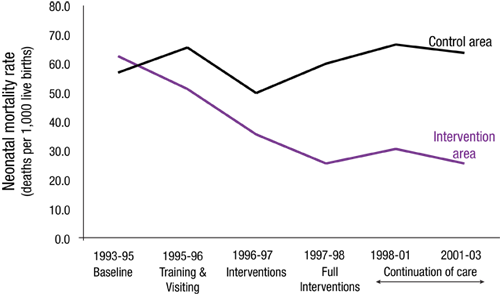Download: SEARCH overview
FAST FACTS
- In 2010, more than 7.5 million children around the world died before their fifth birthday.
- Of these deaths, 3.1 million were newborns less than 28 days old.
- More than 99% of these deaths take place in developing countries.i
- 47% of all mothers and newborns in developing countries do not receive skilled care during birth.ii
- 72% of all babies born outside the hospital do not receive any postnatal care, putting them at high risk for deadly complications.iii
- Three main causes–infection, asphyxia (oxygen deficiency), and preterm birth–account for 86% of all newborn deaths.iv
Around the world, more than three million newborns die in their first month of life every year. Many of these deaths can be prevented using proven and cost-effective interventions. Home-Based Newborn Care packages successfully address the main causes of newborn deaths, decreasing newborn death rates by up to 70%. Village health workers (VHWs) deliver these packages to vulnerable families at the community level, effectively reaching families that lack access to medical facilities.
Home-Based Newborn Care packages are a great “bang for buck” for donors looking to make an impact for vulnerable families and to save lives.
Home-Based Newborn Care (HBNC) packages have been developed to deliver cost-effective interventions to vulnerable populations at the community level, thereby saving newborn lives. These interventions are straightforward, such as using sterile blades to cut umbilical cords, teaching mothers the importance of immediate breastfeeding, and promoting skin-to-skin contact to keep babies warm. However, despite the fact that effective measures have been developed, there is still a great need for these programs to be scaled up and delivered to target populations.
Case Study: Society for Education, Action and Research in Community Health (SEARCH)
The Society for Education, Action and Research in Community Health (SEARCH)v was founded in 1985 by doctors Abhay and Rani Bang in Gadchiroli, India with the stated mission of reducing neonatal mortality by developing a low-cost, home-based model for primary newborn care by utilizing human potential that exists within rural villages. SEARCH developed a Home-Based Newborn Care (HBNC) package which could be delivered at a low cost by community health workers at the village level. Community health workers are women from the local community who are selected and trained by SEARCH in maternal and newborn health. SEARCH also provides community health workers with a basic medical kit including antibiotics and materials to keep low birth weight infants warm. Community health workers are taught to refer mothers and infants to medical facilities for treatment of severe medical problems that cannot be addressed at the community level.
SEARCH works directly with almost 40 villages in India, and it is a site for research, training, and development of globally-recognized best practices. Dr. Bang and his colleagues have used a rigorous evaluation technique to assess the efficacy of their model. In addition, numerous studies on SEARCH’s impact have been published in the most influential journals. Practitioners and public health specialists from around the world have visited SEARCH’s campus in India to learn its approach to HBNC.
Cost/Impact Profile
COST PER IMPACT
- Cost per newborn life saved is approximately $150
- Cost per mother-newborn served is approximately $7
REPRESENTATIVE IMPACTS AND OUTCOMES:
- Decrease in Newborn mortality rate
- Decrease in Case fatality for main causes of newborn deaths
- lmproved maternal health
Home-Based Newborn Care (HBNC): How it works
SEARCH’s model of HBNC provides a continuum of care ranging from maternal to neonatal health coverage. Women from the local communities are selected and trained as Village Health Workers (VHWs). VHWs are trained to provide health education to women in their communities as well as to provide basic care for expecting mothers and newborn children.
Health Education:
VHWs are trained by SEARCH to teach women about healthy behaviors surrounding newborn health. They give expecting mothers printed materials and verbal health messages in one-on-one consultations during their home visits that occur both before and after birth. In addition, VHWs hold group meetings for pregnant women and grandmothers every four months in each village. VHWs give information and demonstrations about important topics such as nutrition, preparation for delivery, breastfeeding, keeping the baby warm, and cleanliness. VHWs also ensure that mothers know how to recognize danger signs in their babies and that the mothers know when they should seek care from a VHW or health facility.
Support in Home Care:
Trained female Village Health Workers (VHWs) advise and assist mothers in neonatal care at home. VHWs are trained to identify and to treat neonatal morbidities like asphyxia, prematurity, low birth weight, sepsis, hypothermia, and infection. VHWs visit new mothers and their babies repeatedly during the first crucial weeks of life equipped with a neonatal care kit that includes simple but life-saving equipment such as blankets, a resuscitation mask, soap, a thermometer, scale, and medications to manage infections. In addition to diagnosing problems, VHWs monitor the baby’s growth and ensure that the mother has support in healthy behaviors such as early breastfeeding, keeping the baby warm, and maintaining good hygiene.
Sickness Management:
In addition to providing basic interventions, care, and treatment at home, VHWs are trained to detect serious conditions and illnesses and to refer families to local health facilities.
Representative Impactsvi
SEARCH’s Home-Based Newborn Care package was field-tested in 39 intervention villages in India for an 8-year period between 1995 to 2003. Vital statistics (including births, deaths, and morbidities) were collected during this period and compared to 47 control villages. Findings from the study show the following positive impacts:
- Decreased newborn deaths: The neonatal mortality rate in intervention villages declined 70% in comparison to that of the control area (see Figure 1).
- Reduced case fatality: Significant reduction in case fatality for the main causes of newborn death – Low Birth Weight (LBW), preterm newborns, sepsis and asphyxia (see Figure 2).
- lmproved maternal health: While the program is not focused directly on maternal health, the project found that maternal morbidities in SEARCH intervention areas were reduced by 49%.
Figure 1: Newborn mortality rate in SEARCH intervention villages VS. control villages

Figure 2: Reduction in case fatalities by type in SEARCH villages

Costvii*/Impact Profile
- Cost of newborn-mother served is approximately $7.
- The annual cost per village is approximately $150–this includes recurring and non-recurring costs of program (average village size is 1,113 people).
- The primary costs of the program include personnel (70%), transport (9%), medicines and supplies (9%), and support (12%).
*Costs given based on analysis from 1995-2003, presented in 2003 prices.
According to estimates from SEARCH staff, costs may have doubled in the past ten years due to inflation.
**DALY is a “Disability-Adjusted Life Year,” and is a metric that combines both survival and disability.
One DALY is equal to one year of healthy life lost due to a health problem. It is used to quantify the burden of disease from specific causes in different regions, to calculate the cost-effectiveness of interventions and to estimate the impact of actual public health programs.
Linking Cost and Impact
- Cost per newborn saved is approximately $150 (calculated as the program total cost of $5349 divided by an average of 36 deaths averted per year).
- When compared to other health interventions targeting newborn health, the HBNC package is one of the most cost-effective. The approximate cost per DALY saved is less than $7 when DALYs discounted, and less than $3 when DALYs are not discounted.**
Take Action
For donors looking for specific organizations that deliver Home-Based Newborn Care packages, here are a few examples:
- Society for Education, Action and Research in Community Health – SEARCH (Gadchiroli). Donors can also give to SEARCH through the US-based 501c3 Indians for Collective Action (find SEARCH in the drop-down menu)
- John Snow International (Nepal)
- BRAC International (Bangladesh)
- Save the Children’s Saving Newborn Lives Initiative (International)
For donors who are already engaged with an organization and are interested in supporting adoption of this approach, here is a checklist of characteristics shared by successful HBNC implementers:
- Areas with high infant mortality rates: Urban and rural areas with high infant mortality rates that will benefit most from the delivery of HBNC.
- Areas where a significant proportion of births take place at home: HBNC packages bring newborn care to families’ homes and therefore are a great resource for populations in which deliveries and newborn care are already occurring in the home. The high proportion of births that take place in the home can result from a variety of factors including tradition, cultural taboos, and a lack of access to medical facilities.
- HBNC as part of a “Continuum of Care”: Programs that are already focused on maternal and children’s health are well-positioned to integrate HBNC packages into their programs. This is true because these programs already offer services to the same target population and will likely use the same community health workers as agents.
- Community consultation: In many parts of the world, there are complex traditional local beliefs, taboos, and practices surrounding pregnancy and childbirth. It is crucial that organizations take these into account when adapting the HBNC for different populations.
- Community acceptance: To ensure that HBNC is accepted and utilized by community members, it is important that organizations choose health workers that are acceptable to the community. It is also important that there is an unmet demand for services and that families are willing to participate in HBNC programs.
- Proper training, selection, and supervision of community-level health workers: Community-level health workers are the primary agents of change on the ground level. It is crucial that health workers are capable and committed to delivering high-quality services. In order to ensure this, screening, supervision, and incentive systems should be in place for volunteer recruitment and retention.
For entrepreneurial donors, here are several new approaches and key innovations for testing and scale-up:
In the case of SEARCH, VHWs deliver injectable antibiotics to treat cases of newborn sepsis (severe infection). While research in the case of SEARCH has demonstrated that health workers can give injections safely, in many countries community health workers are not allowed to give injections by law.
- One organization, PATH, has developed Uniject, a one-time disposable injection, which can be used to deliver antibiotics at a low cost.
- There is an opportunity to fund the development of oral formulations of antibiotics and safe antibiotic delivery methods to treat infections (sepsis) in suspected cases.
There is an opportunity to fund technologies to provide thermal care to low birth weight infants. One approach, called Kangaroo Mother Care, has been proven to be effective in health clinics, but there is still a need for additional testing and adaptation in order to scale the approach for household and community levels.xi
Research findings from Nepal and Bangladesh show that Chlorhexidine applied to umbilical cords of newborn babies by community-level health workers, can significantly reduce neonatal infection, and correspondingly, neonatal deaths from infection. This approach could be scaled-up across developing countries.xii
References i-xii. Photo credit: Healthy Newborn Network.

